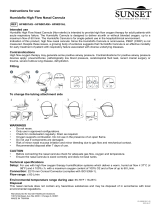
ES - 19A-125
Inicio rápido .............................................................................................. ES - 17
Definiciones de los símbolos .................................................................... ES - 18
Precauciones importantes ......................................................................... ES - 19
Introducción ............................................................................................... ES - 21
Uso previsto ........................................................................................ ES - 21
Población de pacientes prevista ......................................................... ES - 21
Indicaciones de uso / Indicaciones médicas ...................................... ES - 21
Rendimiento Esencial .......................................................................... ES - 21
Por qué su médico le prescribió oxígeno suplementario ................... ES - 21
Cómo funciona el POC iGo2 ............................................................... ES - 21
Cómo funciona la tecnología SmartDose
®
......................................... ES - 21
Descripción general del POC iGo2 .......................................................... ES - 22
Desembalaje y contenido .................................................................... ES - 22
Partes importantes ............................................................................. ES - 22
Armado del sistema ............................................................................ ES - 23
Encendido ........................................................................................... ES - 23
Configuración de la prescripción de oxígeno ...................................... ES - 23
Funcionamiento ......................................................................................... ES - 23
Funcionamiento diario ......................................................................... ES - 23
Utilización del dispositivo..................................................................... ES - 24
Silenciar la condición de alarma ........................................................ ES - 24
Opciones de energía .......................................................................... ES - 24
Almacenamiento ....................................................................................... ES - 24
Almacenamiento a largo plazo ............................................................ ES - 24
Batería ...................................................................................................... ES - 25
Carga inicial de la batería .................................................................. ES - 25
Carga de la batería ............................................................................. ES - 25
Tiempo típico de recarga de la batería .............................................. ES - 25
Cómo viajar con el POC iGo2 .................................................................. ES - 26
Viajes en avión ................................................................................... ES - 26
Autobús / Viajes en tren / Cruceros ................................................... ES - 26
Viajes en vehículos motorizados ........................................................ ES - 26
Campamento / Estadías nocturnas .................................................... ES - 26
Industria del transporte ....................................................................... ES - 26
Viajes internacionales ......................................................................... ES - 26
Elementos de reemplazo/Piezas de repuesto ......................................... ES - 27
Cuidado y limpieza de iGo2 ...................................................................... ES - 27
Cubierta exterior y batería .................................................................. ES - 27
Funda para transporte ........................................................................ ES - 27
Fuente de alimentación, cable de alimentación CA, cable de
alimentación CC ................................................................................. ES - 27
Cánula y tubo ..................................................................................... ES - 27
Solución de problemas y sistema de alarma ........................................... ES - 28
Solución de problemas ....................................................................... ES - 28
Información general de las alarmas ................................................... ES - 28
Sistema de oxígeno de reserva ............................................................... ES - 29
Devolución y eliminación ........................................................................... ES - 29
Eliminación de las baterías de iones de litio ....................................... ES - 29
Mantenimiento ........................................................................................... ES - 29
Cambio del lecho del tamiz ................................................................. ES - 29
Vida útil esperada ................................................................................ ES - 29
Información del proveedor ....................................................................... ES - 29
Lista de verificación inicial del proveedor ........................................... ES - 29
Limpieza y desinfección cuando hay un cambio de paciente ............. ES - 29
Especificaciones ....................................................................................... ES - 30
Modo de información ................................................................................. ES - 31
Información de compatibilidad electromagnética ...................................... ES - 31
Garantia ....................................................................................................... ES - ??
ÍNDICE
DEFINICIONES DE LOS SÍMBOLOS
Peligro: no fume cerca del paciente ni del aparato.
Este símbolo tiene un círculo rojo y una barra
diagonal en la etiqueta del producto.
Botón de encendido
Corriente continua
(alimentación CC)
Alarma silenciada
Es obligatorio leer y comprender las instrucciones de
funcionamiento antes de usar.
Este símbolo tiene un fondo azul en la etiqueta
del producto.
Botón Aumentar ajuste de
receta
Protección eléctrica de
clase II – doble aislamiento
TUV Rheinland
No usar cerca del calor ni del fuego directo
Este símbolo tiene un círculo rojo y una barra
diagonal en la etiqueta del producto.
Botón Disminuir ajuste de
receta
Parte aplicada Tipo BF Fabricante
No desarme el aparato
Este símbolo tiene un círculo rojo y una barra
diagonal en la etiqueta del producto.
Símbolo indicador del
estado de la batería
Núm. de catálogo
Marcado CE como
Representante europeo
No use aceite, grasa ni lubricantes
Este símbolo tiene un círculo rojo y una barra
diagonal en la etiqueta del producto.
Oxígeno normal (verde) Número de serie
European Rep CE Mark
Norma RTCA / DO-160G, Sección 21, Categoría M y
Sección 20, Categoría T - El fabricante de este POC
ha determinado que este dispositivo cumple con todos
los criterios de aceptación de la FAA aplicables para el
transporte y uso del POC a bordo de aeronaves.
El texto que se muestra con este símbolo es rojo
en la etiqueta del producto.
Oxígeno bajo (amarillo)
No RM (Inseguro para RM) Inseguro para el entorno de
resonancia magnética
Advertencia general
Este símbolo se usa a lo largo de este manual
para indicar situaciones peligrosas que debe
evitar.
Mantenimiento requerido
(rojo)
La ley federal (de los EE. UU.) restringe la venta de este aparato,
el cual solo puede ser vendido por un médico o con la
prescripción de este.
Información importante
Este símbolo se usa a lo largo de este manual
para indicar información importante que usted
debe conocer.
IP22
Protección contra ingresos IP22: protegido contra el acceso de los dedos a las piezas peligrosas;
protegido contra la caída vertical de gotas de agua en caso de inclinación de la carcasa hasta 15°.
Nota y símbolo de información
Este símbolo se usa a lo largo de este manual
para indicar notas, consejos útiles,
recomendaciones e información.
Este dispositivo contiene un equipo eléctrico y/o electrónico que debe reciclarse de acuerdo con la
Directiva 2012/19/UE de la Unión Europea – Equipo Eléctrico y Electrónico de Desecho (WEEE)





















